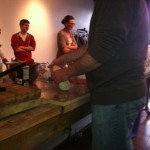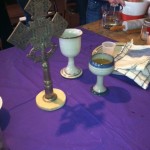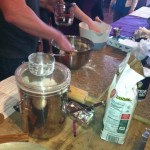Baker In Residence
My home congregation, Humble Walk, does not have a full time song leader. It has an artist in residence program. Different artists come in and lead music for a season or handful of weeks at a time. It works and opens us to a wide variety of music. When playing elsewhere it’s often assumed that I lead music a ton at Humble Walk. I don’t. One of the main reasons has to do with me having two kids along with me and there are few things I dislike more than bringing my kids to work. That being said, when I am asked to do it I usually say yes because I love my church and I love leading music and my lovely wife can usually find some extra hands to help out on her end of things to make it tolerable with the kids.
Last week I said yes. Mostly because Coordinator Justin asked me as an artist to make bread not music. 99% of the time our artists are musicians and 1% has been visual artists like this guy. (Matt is the 1%)
So my art was to be baking bread. Which I love. So I said yes.
Here’s how it went down.
Justin and I met up. The challenge in creating interactive experiences is to find the avenue that allows the unpracticed to participate. The balance necessary in leadership is to provide instruction and structure so that success is measured not in performance (yuck.) but in participation (yeah!) How do you do this with bread? See, that’s why Justin and I had to meet up. Though bread is more forgiving than most (myself included) it’s also weirdly mysterious to the point that it intimidates. Making a loaf of bread takes more time than talent. And somedays I would argue a healthy dose of ‘ignorance is bliss.’ Perhaps bread baking suits me for these qualities. I’m okay with that.
Here are the opportunities for creative thinking that we needed to address:
- no access to a kitchen
- 45 minutes from start to finish (give or take)
- our alter/prep counter is an artists table covored in paint and gouged wood
- 15-30 particpants – not observers- this wasn’t to be a demonstration but rather an active part of worship
- connection to the gospel – our songs support the theme, how could bread do that?
- pacing through the service
- gluten free inclusivity
We first came up with a somewhat elaborate scheme to bring dough in at different stages, including baked loaves. This seemed like the most realistic plan giving our limitations but it also seemed to fit the limitations better than the goal of participation. We wanted to embrace both.
What we came up with was tortillas.
An unleavened (or chemically leavened – baking powder in this case) bread. The dough would need time to rest but not to rise. Each person could make his or her own tortilla. We could bake them on a griddle, no need for a kitchen and we could make corn tortillas as well for a gluten free option. And of course there was still a gospel connection to make and pacing through the service.
The gospel lesson was about Jesus in the wilderness. Satan challenges him saying, “If you are the son of God turn this stone into bread.” Bread reference. Bam. But so what? There’s a bigger theme I went with. There are proteins in flour that come together to create gluten. You want strong gluten development in bread to create a sort of skin of elasticity that will hold the dough together, and in the case of leavened bread, hold in the CO2 produced by the yeast. It’s what makes bread rise. To form that gluten you need TIME and TENSION. Kneading creates that tension that brings the proteins together. So does time (the key to many no-knead breads). The balance of both offers you workable dough and beautiful flavor. Time: 40 days. Tension: Temptation.
Bread baking now reinforced the text and the season.
And the pacing? Here’s the recipe:
You’ll need a workspace. I used the leftover counter top from where my favorite mother-in-laws sink had been cut out and made two portable workstations, one for flour, one for corn. We made this on a lefse griddle cranked all the way up. It did not work as smooth as the cast iron tortilla pan my Aunt Alice gave me when she taught me how to make tortillas, but it worked.
GATHER
Our ‘opening song’ was making the dough. Two batches of flour, one of corn. The corn tortilla was on the back of the corn flour bag and is way easy, so I’m just going to talk about the flour tortillas here. Folks helped measure and knead and everyone had an opportunity to join in and get messy.
4 cups flour
1 tsp salt
2 tsp baking powder
2 Tbl shortening/lard (we used butter flavored crisco)
1 1/2 cups warm water (hot out of the tap works well)
Do this:
Mix dry ingredients
Crumble in the shortening/lard with your fingers
Add warm water and knead with your hands until it is well combined and smooth. A stand mixer will do this at home in about 3 minutes. A slightly sticky dough is good. Super sticky? Bad. Super dry? Bad. So be good and slightly sticky.
Place the dough in a bowl and let it rest till after the sermon. (10-20 minutes of rest)
WORD

Divided the first batch of flour dough into 24 pieces and put the pieces in a bowl. Pass the bowl around and each person takes out a piece and rolls it between their hands to form a ball. Then, as ready, come around the alter and roll it out. You can’t roll it to thin. Dust with flour as needed. The corn tortillas we did with a homemade press which went quickly so folks came up and made corn tortillas at the alter.
Lay on the griddle till one side bubbles. Flip over for a bit. Little brown dots on each side is coolio.
With the scent of tortillas baking we moved into prayer, letting them rise as floured incense.
MEAL

As tortillas were prepared we piled them on to the communion plate (Paten). Communion was served by intinction one warm tortilla at a time.
SEND
I busted out butter, cinammon and sugar as well as plastic wrap and we were sent with something sweet and a few tortillas to take home. Actually, very few… if any. We did a pretty good job of finishing them off. But there was still dough left, so that was wrapped up and sent home with willing spirits that were ready to try something new.
And that’s how bread worked as the art of our worship.
As is often the case, worship was messy. Fluid. Hiccupy. And beautiful. It was actually more beautiful then I would’ve guessed it to be and for that I thank Justin Rimbo for his vision and my faith community for her support.
